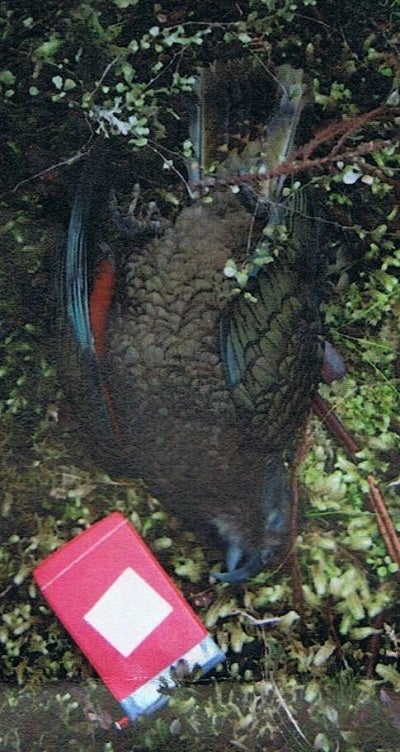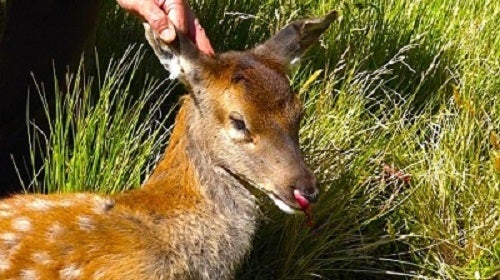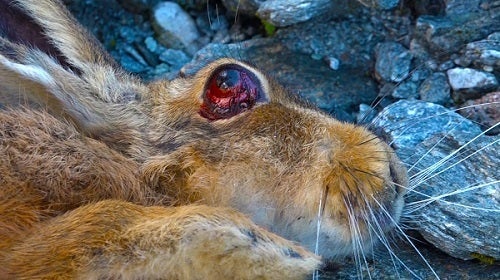*Co-authored with Bill Benfield, author and resident of the North Island of New Zealand
New Zealand’s image to the world is one of unspoiled paradise. Stunning mountain peaks, crystal clear rivers, unspoiled national parks, and a brilliant “100% Pure” advertising campaign attracts travelers from around the globe.
International tourism contributes an estimated $11.8 billion to New Zealand’s economy, and employs over 188,000 people. Would this pivotal industry be jeopardized if tourists knew about New Zealand’s bizarre program of whole ecosystem poisoning to eradicate animal species deemed pests?
For over 60 years, under the guise of “conservation,” the New Zealand Department of Conservation (DoC), and other agencies, have been using helicopters to aerially drop a deadly toxin known as Compound 1080 (sodium monofluoroacetate) across vast areas of wilderness, waterways and even agricultural regions. Other rodenticides proven fatal to wildlife, such as brodifacoum, diphacinone, cyanide and chlorophacinone, are also used.
For Tourists – The Mt. Aspiring Experience
This recent video, taken by wildlife documentary filmmaker Clyde Graf, shows the shocked reactions of tourists after learning they were hiking and swimming in waterways in the midst of a helicopter drop of Compound 1080, a lethal toxin with no known antidote.
Documented evidence and stories of wildlife (both native species and introduced), livestock, and pets suffering from horrific poisoning is not a topic that gets much press, neither inside nor outside New Zealand. However, with the explosion of social media, there are approximately 30 different Facebook groups opposed to the New Zealand government’s continued use of 1080, and other rodenticides.
The astonishing myth that is perpetuated by U.S. Fish and Wildlife, when looking to promote island eradication projects such as the Farallon Islands (recently halted by public opposition and funding challenges) and now Lehua Island in Hawaii, is that New Zealand’s Department of Conservation are the “experts” in pest control, and provide technical assistance for all projects.
An article published by the Huffington Post, New Zealand 100% Pure Shattering the Illusion of Green, Clean and Pristine, reveals the dark side of conservation practices in New Zealand, so xenophobic and lacking in scientific integrity that entire ecosystems are poisoned in the process.
Concerns regarding the aerial poisoning practices undertaken by the government have escalated to outrage and public protests by many, especially those living in the rural areas of New Zealand.
What is Compound 1080?
Sodium monofluoroacetate, known as “Compound 1080” is a controversial and insidious toxin that was first patented in 1927 as an insecticide. After WWII, it was used in the U.S. for rodent control, and during the years 1946 - 1949, at least 12 people died of accidental poisoning. In 2007, U.S. Representative Peter DeFazio, at the request of Predator Defense, introduced a bill that would ban the use of both 1080 and sodium cyanide in the U.S.
"Both of these poisons have been called "super poisons" by the FBI, and have been cited as lethal toxins likely to be used by terrorists to harm Americans" DeFazio said. "These poisons have sickened dozens of humans, and have killed many more pets and wildlife over the years."
Compound 1080 is odorless and colorless; one teaspoon can kill up to 100 people. Current usage of 1080 in the U.S. is limited to barbaric livestock collars, to supposedly protect sheep and goats from predators. Legal use is restricted to nine states. (Livestock collar photos courtesy of Predator Defense)
The bill introduced in 2007 failed to make it out of committee. However, on March 30, 2017, again at the request of Predator Defense, Congressman DeFazio introduced H.R. 1817, the Chemical Poisons Reduction Act of 2017, which would ban the use of Compound 1080 and sodium cyanide for predator control in the U.S.
Bill Benfield
After my first article on the proposed Farallon Islands project was published by Huff Post in 2014, Bill Benfield, the author of two books on this topic, introduced me to New Zealand’s history and love affair with aerially dropping poisons from aircraft. He highlighted how New Zealand has been exporting this industry around the world by way of New Zealand’s Island Eradication Advisory Group (IEAG)
As Bill Benfield explained:
“It all started early last century, when a plant collector and gardener, with no formal qualification in botany, gained national credence with near hysterical campaigns against introduced animals. Leonard Cockayne (honorary PhD) claimed deer browse would strip the forest from the mountains, causing massive erosion that would destroy towns and farms on the plains; ignoring all evidence that the forests had been intensively browsed without harm prior to human arrival. The nation bought into this false crisis, and since 1930, New Zealand has waged a war against nature as a major and lucrative conservation industry. In the 1950’s the program expanded to using “super toxin” 1080. It is a war against demonized wildlife that has escalated into the poisoning of whole ecosystems, supposedly with the intention of eradicating non-native “pests.”
Cockayne was influential in New Zealand’s conservation group, Forest and Bird, who still use his “conservation crisis” as a powerful marketing tool for their own fundraising.
Despite 60+ years of poisoning, spending around NZ$ 150 million a year, New Zealand continues to be in a crisis of declining native fauna.
Rather than critically examining the program, the government conservation agency, DoC, has aligned with corporate donors to escalate efforts to a nationwide poisoning and trapping program known as “PFNZ” (Predator Free NZ). The goal is to totally eradicate ALL rats, stoats, possums, deer, and other animals deemed undesirable, by 2050. Funding estimates for PFNZ come in at an astounding NZ$ 27 billion!
Wars are driven by money and ideology and the “war on invasive species,” which manipulates public opinion by engaging the use of military metaphors, propaganda, and vilification of an enemy, parallels the bloodshed (including the deplorable acceptance of non-target species as collateral damage) that has taken place in wars throughout history.
The New Zealand Department of Conservation is the major driver of aerial poisoning, and they are joined in this destruction by OSPRI, a group set up to eradicate NZ’s non-existent bovine TB by poisoning wild animals. It should be noted that NZ is, by world standards, TB free. It is a poisoning program that is endorsed by conservation NGOs such as Forest & Bird, WWF, and the Kea Conservation Trust – all groups that capitalize on “the crisis” for fundraising appeals.
The public face of “PFNZ” may be cloaked as conservation zealotry, but the real drivers are money, prestige, and the public honors they attract.
A casual observer may reasonably believe that DoC is farming rats to maintain its conservation crisis. Every time there is a poison drop, all life, with the exception of a small member of the weasel family called a stoat, experiences a population crash. From then on, it’s the race of the fastest breeders – which of course, are rats and mice. DoC’s own science tells us that approximately two years after a drop, the rat population can rise to three times its pre-drop levels.
Slow breeding birds, the same species the program is supposed to protect, have proven to be the most at risk, as shown by the Graf Boy’s movie on protecting kiwi at a bird sanctuary.
The likely outcome is already becoming apparent; kiwi populations are currently collapsing in regions where DoC has engaged in aerial or ground poisoning operations.
Some birds, such as the world’s only mountain parrot – the kea, are extinct in much of their endemic range. The collapse of the kea population is not from predators, but from continual use of toxic predator control.
This public records request, called an “Official Information Act” (OIA) in New Zealand, requested information concerning the deaths of seven kea in the North Okarito Forest following a 1080 poison drop in 2011. This map, released in response to this OIA request, illustrates the locations of seven kea found dead after the drop of 1080, and the photo below is one of the kea poisoned in this “conservation” project. News coverage of the poisoning of kea can be found here.

This kea was one of seven poisoned during the North Okarito Forest 1080 drop.
Considering the failure rate for island eradications globally, which includes Henderson, Desecheo, Wake Island, Lehua (2009) and Enderbury, the prospects for a “Predator-Free New Zealand,” are hopeless. A program, driven by the industrial conservation complex’s demands of repeated and indefinite applications of deadly poisons, will ultimately come at great expense to New Zealand’s tourism, food production, and imperiled wildlife.

Fawn poisoned during Mt. Aspiring 1080 drop.

Hare poisoned during Mt. Aspiring 1080 drop,
Special thanks to Clyde and Steve Graf for their uncompromising fearlessness in documenting and providing evidence of the cruelty and suffering that is a direct result of New Zealand’s poisoning programs.
